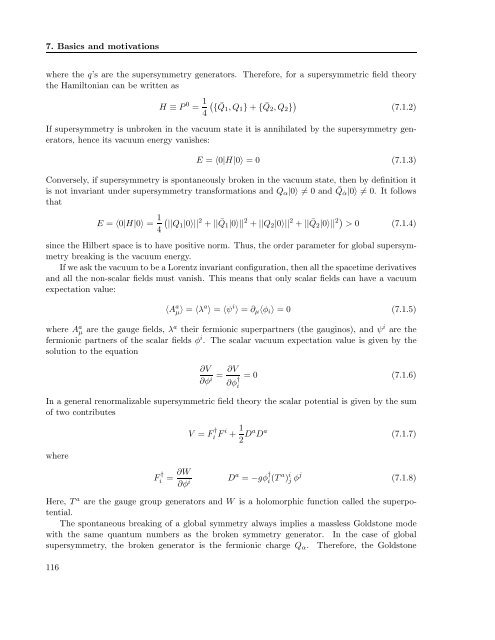Perturbative and non-perturbative infrared behavior of ...
Perturbative and non-perturbative infrared behavior of ...
Perturbative and non-perturbative infrared behavior of ...
You also want an ePaper? Increase the reach of your titles
YUMPU automatically turns print PDFs into web optimized ePapers that Google loves.
7. Basics <strong>and</strong> motivations<br />
where the q’s are the supersymmetry generators. Therefore, for a supersymmetric field theory<br />
the Hamiltonian can be written as<br />
H ≡ P 0 = 1 <br />
{ Q1,Q1} ¯ + {<br />
4<br />
¯ Q2,Q2} <br />
(7.1.2)<br />
If supersymmetry is unbroken in the vacuum state it is annihilated by the supersymmetry generators,<br />
hence its vacuum energy vanishes:<br />
E = 〈0|H|0〉 = 0 (7.1.3)<br />
Conversely, if supersymmetry is spontaneously broken in the vacuum state, then by definition it<br />
is not invariant under supersymmetry transformations <strong>and</strong> Qα|0〉 = 0 <strong>and</strong> ¯ Q ˙α|0〉 = 0. It follows<br />
that<br />
E = 〈0|H|0〉 = 1 <br />
||Q1|0〉||<br />
4<br />
2 + || ¯ Q1|0〉|| 2 + ||Q2|0〉|| 2 + || ¯ Q2|0〉|| 2 > 0 (7.1.4)<br />
since the Hilbert space is to have positive norm. Thus, the order parameter for global supersymmetry<br />
breaking is the vacuum energy.<br />
If we ask the vacuum to be a Lorentz invariant configuration, then all the spacetime derivatives<br />
<strong>and</strong> all the <strong>non</strong>-scalar fields must vanish. This means that only scalar fields can have a vacuum<br />
expectation value:<br />
〈A a µ 〉 = 〈λa 〉 = 〈ψ i 〉 = ∂µ〈φi〉 = 0 (7.1.5)<br />
where A a µ are the gauge fields, λ a their fermionic superpartners (the gauginos), <strong>and</strong> ψ i are the<br />
fermionic partners <strong>of</strong> the scalar fields φ i . The scalar vacuum expectation value is given by the<br />
solution to the equation<br />
∂V ∂V<br />
=<br />
∂φi ∂φ †<br />
i<br />
= 0 (7.1.6)<br />
In a general renormalizable supersymmetric field theory the scalar potential is given by the sum<br />
<strong>of</strong> two contributes<br />
where<br />
F †<br />
i<br />
= ∂W<br />
∂φ i<br />
V = F †<br />
i F i + 1<br />
2 Da D a<br />
D a = −gφ †<br />
i (T a ) i j φj<br />
(7.1.7)<br />
(7.1.8)<br />
Here, T a are the gauge group generators <strong>and</strong> W is a holomorphic function called the superpotential.<br />
The spontaneous breaking <strong>of</strong> a global symmetry always implies a massless Goldstone mode<br />
with the same quantum numbers as the broken symmetry generator. In the case <strong>of</strong> global<br />
supersymmetry, the broken generator is the fermionic charge Qα. Therefore, the Goldstone<br />
116
















